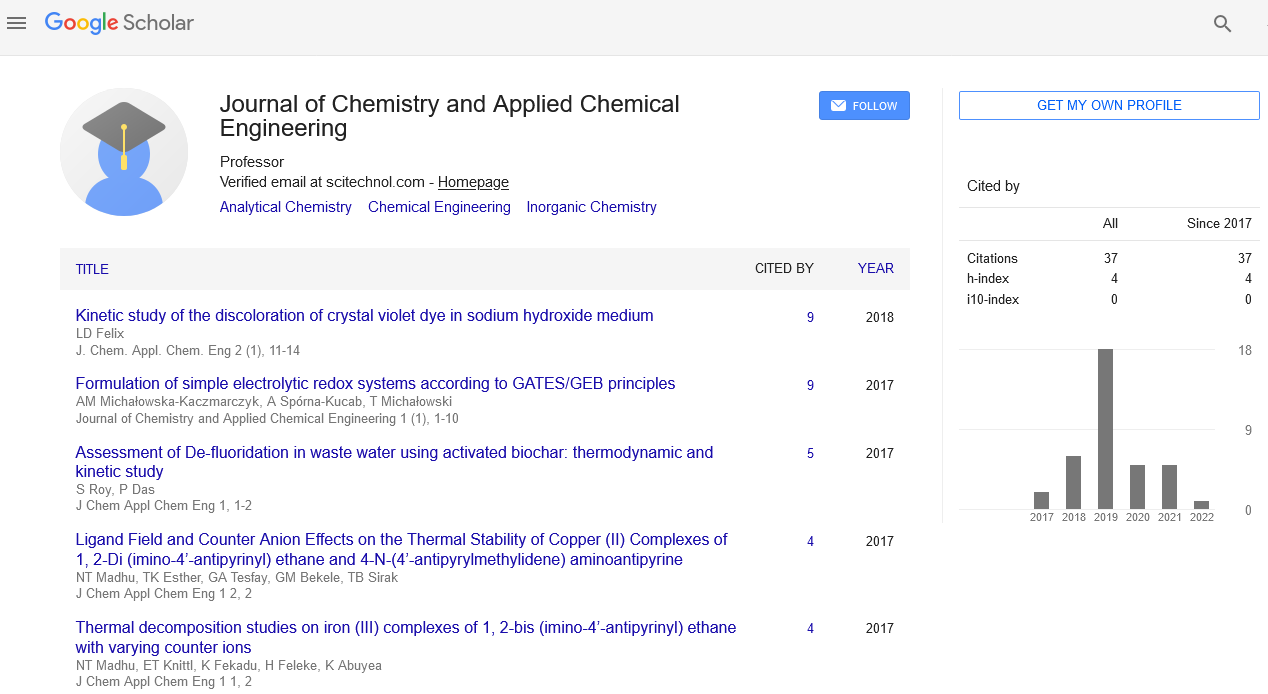Commentary, J Chem Appl Chem Eng Vol: 6 Issue: 2
Electroactive Polymer Nanoparticles Exhibiting Photothermal Properties: synthesis of electroactive polymers
Jennifer Irvin
Department of Biomedical Engineering, Materials Science, Engineering and Commercialization Program, Texas State University, US
*Corresponding Author: Dr. Jennifer Irvin, Department of Biomedical Engineering, Materials Science, Engineering and Commercialization Program, Texas State University, US, E-mail: anishkhan97@gmail.com
Received date: 04 March, 2022, Manuscript No. JCACE-22-56445;
Editor assigned date: 07 March, 2022, PreQC No. JCACE-22-56445 (PQ);
Reviewed date: 17 March, 2022, QC No. JCACE-22-56445;
Revised date: 24 March, 2022, Manuscript No. JCACE-22-56445 (R);
Published date: 31 March, 2022, DOI: 10.4172/Jcace.1000e006
Citation: Irvin J (2022) Electroactive Polymer Nanoparticles Exhibiting Photothermal Properties: synthesis of electroactive polymers. J Chem Appl Chem Eng 6:2.
Keywords: Electroactive polymers , Nanoparticles, Electropolymerization
Introduction
A technique for the synthesis of electroactive polymers is verified, beginning with the synthesis of prolonged conjugation monomers the usage of a 3-step manner that finishes with Negishi coupling. Negishi coupling is a pass-coupling manner wherein a chemical precursor is first lithiated, accompanied through transmetallation with ZnCl2. The resultant organozinc compound may be coupled to a dibrominated fragrant precursor to provide the conjugated monomer. Polymer movies may be organized thru electropolymerization of the monomer and characterised the usage of cyclic voltammetry and ultraviolet-visible-close to infrared (UV-Vis-NIR) spectroscopy. Nanoparticles (NPs) are organized thru emulsion polymerization of the monomer the usage of a two-surfactant gadget to yield an aqueous dispersion of the polymer NPs. The NPs are characterised the usage of dynamic mild scattering, electron microscopy, and UV-Vis-NIR-spectroscopy. Cytocompatibility of NPs is investigated the usage of the mobileular viability assay. Finally, the NP suspensions are irradiated with a NIR laser to decide their effectiveness as ability substances for photothermal therapy (PTT).
Electroactive Polymers
Electroactive polymers extrade their properties (color, conductivity, reactivity, volume, etc.) withinside the presence of an electric powered field. The speedy switching times, tunability, durability, and light-weight traits of electroactive polymers have caused many proposed programs, inclusive of opportunity power, sensors, electrochromics, and biomedical gadgets. Electroactive polymers are doubtlessly beneficial as flexible, mild-weight battery and capacitor electrodes. Applications of electroactive polymers in electrochromic gadgets consist of glare-discount structures for homes and automobiles, sunglasses, defensive eyewear, optical garage gadgets, and clever textiles. Smart home windows can lessen power necessities through blockading unique wavelengths of mild on-call for and shielding interiors of houses and automobiles. Smart textiles may be utilized in apparel to assist defend in opposition to UV radiation. Electroactive polymers have additionally all started for use in clinical gadgets. Among electroactive polymers utilized in biomedical gadgets, polypyrrole (PPy), polyaniline (PANI), and poly (3,4-ethylenedioxythiophene) (PEDOT) are most of the maximum common. For example, those kinds of polymers are normally used as transducers in biosensor gadgets.7 Applications in healing shipping have additionally proven promise; research have verified the discharge of medicine and healing proteins from gadgets organized from electroactive polymers. More recently, electroactive polymers had been used as healing sellers in photothermal therapy.13-15 In photothermal therapy, photothermal sellers should soak up mild withinside the close to-infrared (NIR) location (~700−900 nm), additionally called the healing window, wherein mild has the most intensity of penetration in tissue, usually up to one cm. In this variety, organic chromophores along with hemoglobin, oxygenated hemoglobin, lipids, and water have little-to-no absorbance, which permits mild to penetrate without difficulty. When photothermal sellers soak up mild on this healing window, the photoenergy is transformed to photothermal power.
Irvin and co-people have formerly said alkoxy-substituted bis-EDOT benzene monomers that have been synthesized the usage of Negishi coupling. Negishi coupling is a favored technique for carbon-carbon bond formation. This manner has many blessings, inclusive of using organozinc intermediates, which might be much less poisonous and have a tendency to have better reactivity than different organometallics used. Organozinc compounds also are well suited with a extensive variety of practical organizations at the organohalides. In the Negishi coupling reaction, an organohalide and organometal are coupled via using a palladium(0) catalyst. In the paintings supplied herein, this pass coupling technique is applied withinside the synthesis of 1, 4-dialkoxy-2,5-bis(3,4-ethylenedioxythienyl) benzene (BEDOT-B(OR)2) monomers. These monomers can then be without difficulty polymerized electrochemically or chemically to yield polymers which are promising applicants to be used in biomedical programs.
Conventional strategies for practice of colloidal polymeric suspensions in aqueous answers for biomedical programs usually contain the dissolution of bulk polymers accompanied through nano-precipitation or emulsion-solvent evaporation techniques. In order to supply NPs of poly (BEDOT-B(OR)2), a bottom-up technique is verified right here wherein the NPs are synthesized thru in situ emulsion polymerization. Emulsion polymerization is a manner this is without difficulty scalable and is a tremendously rapid technique for NP practise. Studies the usage of emulsion polymerization to supply NPs of different electroactive polymers had been said for PPy and PEDOT. PEDOT NPs, for example, had been organized the usage of spray emulsion polymerization.24 this technique is hard to reproduce, and usually yields larger, micron-sized particles. The protocol defined in this text explores using a drop-sonication technique to reproducibly put together 100-nm polymer NPs.
 Spanish
Spanish  Chinese
Chinese  Russian
Russian  German
German  French
French  Japanese
Japanese  Portuguese
Portuguese  Hindi
Hindi 